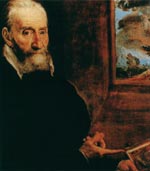The
natural particularities and the exceptionally favourable geographical
position for traffic between Middle Europe and the Mediterranean
have brought about an early settlement of these regions. That
has been confirmed also by the discovered remains of numerous
settlements of the prehistoric inhabitants, Liburnians. In antique
times a diverging road of an imp ortant
Roman road leading from Italy to Dalmatia spread along the seaside.
Alongside the roads there were resting stations and stations for
changing horses, agricultural estates, commercial ports and rural
houses. The settlement of the Croatian tribes on these territories
was completed by the end of the 8th century. The Croatians brought
a specific spiritual and material culture, which can be testified
by exceptional examples of jewelry found in the Old Croatian necropolis
Strance-Gorica near Crikvenica. The family of the princes of Frankopan
ruled in the principality of Vinodol for nearly 450 years. During
their rule the Frankopans controlled not only the economic but
also the cultural development. It is their merit that one of the
oldest Europe an
laws, the Law of Vinodol, was passed in 1288. In that law the
main legal and democratic principles of the social life of the
inhabitants of the littoral region were defined. The Frankopans
were also considerable donors and constructors of churches. Thus
it was in 1412 that prince Nikola IV had a monastery built for
the monks of Saint Paul the Hermit close to the very ancient small
church situated near the place where the river Dubracina empties
into the sea, in which way the future Crikvenica was founded.
The monks cherished the national language and used the Croatian
Glagolitic alphabet, they cured the populace and ran a school
which was attended also by Juraj Julije Klovic, later the
mo st
famous painter miniaturist in the world. The small resorts constituting
the present town of Crikvenica were originally ports of medieval
towns in the valley of Vinodol. Most developed was the port in
Selce, and about the end of the l9th century new ports were built
with strong stone break-waters, which have subsisted until this
day. They prove the skill of the constructors and stone-masons,
by which the inhabitants of this region were known and respected
all over the world. By the end of the last century the first touri
sts
began to visit Crikvenica, and subsequently also the other parts
of this Riviera. This stimulated the construction of hotels, bathing
establishments, villas and the laying down of parks and promenades.
During the last one hundred years the resorts of the Riviera have
considerably changed. Nowadays they appear as a mixture of modern
buildings with the tourist architecture of the last century and
the traditional popular architecture, representing integral parts
of particular harmony and charm. At present in the resorts of
the Riviera of Crikvenica, especially during summer, various events
take place - from exhibitions and concerts to performances and
sports events and competitions. The visitors can get acquainted
with interesting popular customs, while gourmets will appreciate
certain dishes prepared in a manner typical for the region.
st
famous painter miniaturist in the world. The small resorts constituting
the present town of Crikvenica were originally ports of medieval
towns in the valley of Vinodol. Most developed was the port in
Selce, and about the end of the l9th century new ports were built
with strong stone break-waters, which have subsisted until this
day. They prove the skill of the constructors and stone-masons,
by which the inhabitants of this region were known and respected
all over the world. By the end of the last century the first touri
sts
began to visit Crikvenica, and subsequently also the other parts
of this Riviera. This stimulated the construction of hotels, bathing
establishments, villas and the laying down of parks and promenades.
During the last one hundred years the resorts of the Riviera have
considerably changed. Nowadays they appear as a mixture of modern
buildings with the tourist architecture of the last century and
the traditional popular architecture, representing integral parts
of particular harmony and charm. At present in the resorts of
the Riviera of Crikvenica, especially during summer, various events
take place - from exhibitions and concerts to performances and
sports events and competitions. The visitors can get acquainted
with interesting popular customs, while gourmets will appreciate
certain dishes prepared in a manner typical for the region.